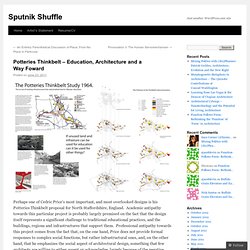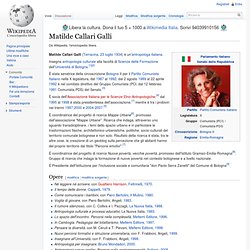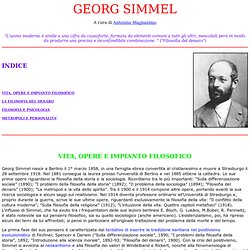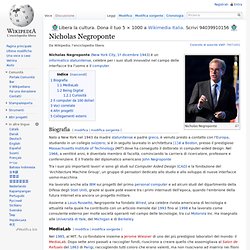

Potteries Thinkbelt – Education, Architecture and a Way Foward. Perhaps one of Cedric Price’s most important, and most overlooked designs is his Potteries Thinkbelt proposal for North Staffordshire, England.

Academic antipathy towards this particular project is probably largely premised on the fact that the design itself represents a significant challenge to traditional educational practices, and the buildings, regions and infrastructures that support them. Professional antipathy towards this project comes from the fact that, on the one hand, Price does not provide formal responses to complex social functions, but rather infrastructural ones, and, on the other hand, that he emphasizes the social aspect of architectural design, something that few architects are willing to either accept or acknowledge, largely because of the negative connotations of “social engineering” frequently attributed to consciously socially centered design strategies.
This assessment applies equally to the liberal arts as it does to the “pure” sciences. Like this:
Università di Urbino "Carlo Bo" - Academia.edu. This issue of Sociologica will explore the numerous ways in which the contemporary diffusion of locative and mobile media puts into relief the spatialization of communication events, as well as the communicative quality of places, in a condition of diffuse addressability (Mitchell).

This underlines a co-emergence of information and sociospatial formations, pointing to the performativity of both (Mackenzie; Thrift). The issue also foregrounds the way in which the relation between the subjects and objects of communication also changes in such contexts of distributed agency and pervasive mediation, in which new sociotechnical formations emerge. Contributions focusing on empirical case studies as well as methodological and theoretical reflections on (but not limited to) the following topics are welcomed: Drew Hemment. The Smithsons and adaptive architecture. I've been reading a bit about The Smithsons and Cedric Price, forerunners both of Archigram and much innovative thinking in post-war British architecture.

On the former, there's a fabulous book called The Charged Void: Architecture [UK|US] cataloguing and reflecting on the work of Alison and Peter Smithson. They're known principally for groundbreaking Hunstanton School (1949-54) [+ve|-ve]; their landmark 'House of the Future' at the Ideal Home show (1956); Sheffield University (1953); The Economist building in central London (1959-64); participating in the legendary This Is Tomorrow exhibition (1956); hanging out with Eduardo Paolozzi, Nigel Henderson, and Reyner Banham; and the Robin Hood Garden housing complex in Poplar, east London (1966-72), the high-profile failure of which largely did for their reputation. I scribbled these notes from this incredibly handsome book whilst sitting in Borders.
Please excuse any misquotes and the hasty sketch. Hannah Arendt Discusses Philosophy, Politics & Eichmann in Rare 1964 TV Interview. Hannah Arendt’s work has come under some critical fire lately, what with the release of the Margarethe Von Trotta-directed biopic, starring German actress Barbara Sukowa as the controversial political theorist.

At issue in the film and the surrounding commentary are Arendt’s (allegedly misleading) characterizations of the subject of her 1963 book Eichmann in Jerusalem, as well as her ambivalent—some have said callous, even “victim-blaming”—treatment of other Jews. None of these controversies are new, however. As Arendt scholar Roger Berkowitz notes in a recent New York Times editorial, at the time of her book’s publication, “Nearly every major literary and philosophical figure in New York chose sides in what the writer Irving Howe called a ‘civil war’ among New York intellectuals.” While acknowledging Arendt’s flaws, Berkowitz seeks to exonerate the best-known concept that emerged from her work on Eichmann’s trial, the “banality of evil.” Related Content: Matilde Callari Galli. Da Wikipedia, l'enciclopedia libera.

Matilde Callari Galli (Terracina, 23 luglio 1934) è un'antropologa italiana. Insegna antropologia culturale alla facoltà di Scienze della Formazione dell'Università di Bologna.[1][2] È stata senatrice della circoscrizione Bologna II per il Partito Comunista Italiano nella X legislatura, dal 1987 al 1992; dal 2 agosto 1989 al 22 aprile 1992 è nel comitato direttivo del Gruppo Comunista (PCI, dal 12 febbraio 1991 Comunista-PDS) del Senato.[3] È socia dell'Associazione Italiana per le Scienze Etno-Antropologiche;[4] dal 1995 al 1998 è stata presidentessa dell'associazione,[1] mentre è tra i probiviri nei trienni 1997-2000 e 2004-2007.[5]
James Irwin. Pierre Lévy. Franco Berardi. John Urry (sociologist) John Urry (/ˈʊəri/; born 1946) is a British sociologist, Professor at Lancaster University.

He is noted for work in the fields of the sociology of tourism and mobility. He has written books on many other aspects of modern society including the transition away from 'organised capitalism', the sociology of nature and environmentalism, and social theory in general. Urry is a Fellow of the Royal Society of Arts, a Founding Academician of the UK Academy of Learned Societies for the Social Sciences and a Visiting Professor at both Bristol and Roskilde Geography Departments. GEORG SIMMEL. Simmel ha formulato interessanti riflessioni di carattere sociologico in virtù delle quali viene considerato uno dei padri della sociologia.

Nicholas Negroponte. Da Wikipedia, l'enciclopedia libera.

Nicholas Negroponte Nicholas Negroponte (New York City, 1º dicembre 1943) è un informatico statunitense, celebre per i suoi studi innovativi nel campo delle interfacce tra l'uomo e il computer. Biografia[modifica | modifica sorgente] Nato a New York nel 1943 da madre statunitense e padre greco, è venuto presto a contatto con l'Europa, studiando in un collegio svizzero; si è in seguito laureato in architettura [1] a Boston, presso il prestigioso Massachusetts Institute of Technology (MIT) dove ha conseguito il dottorato in computer-aided design. Nel 1966, a ventitré anni, è diventato membro di facoltà, cominciando la carriera di ricercatore, professore e conferenziere.